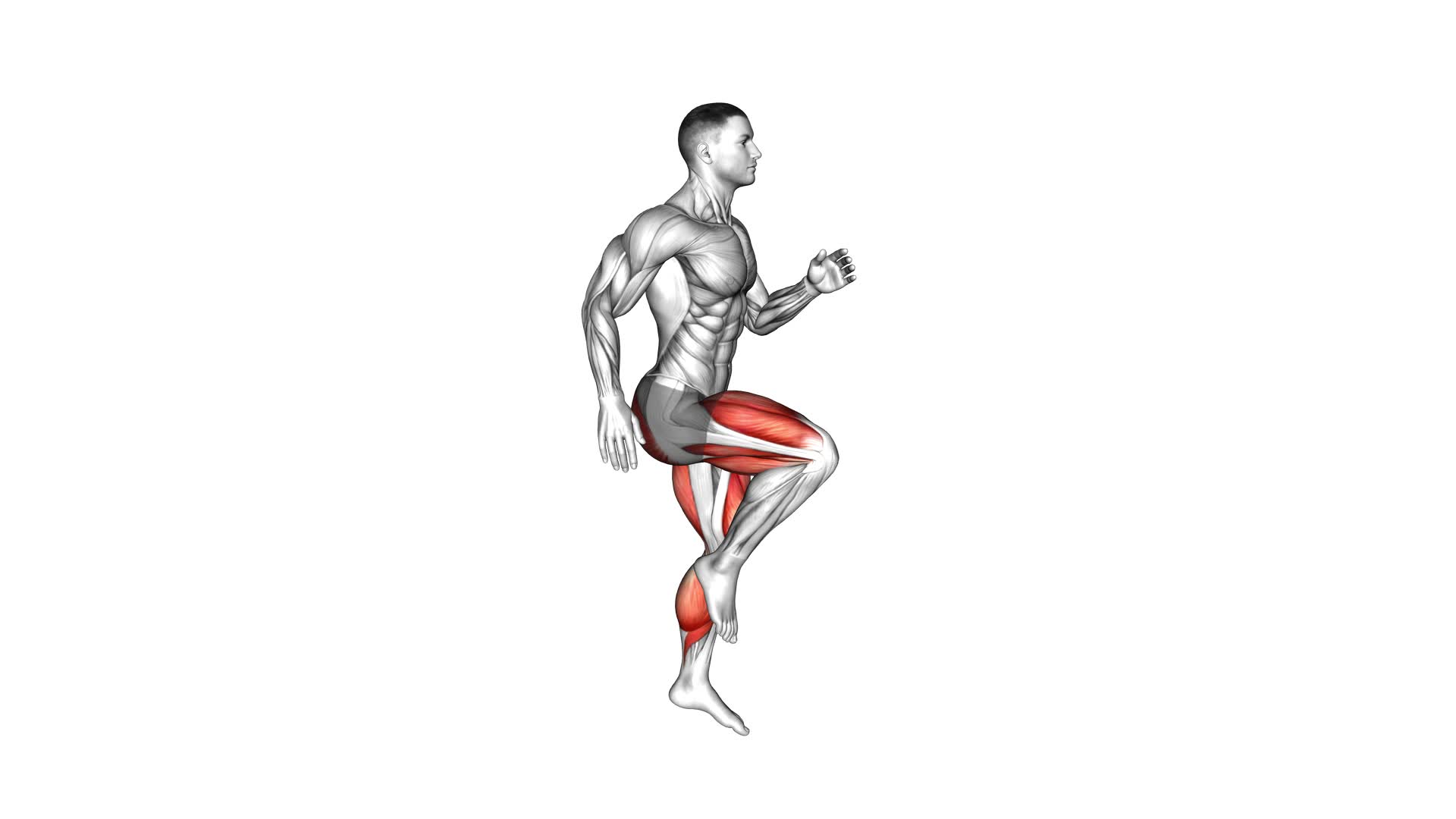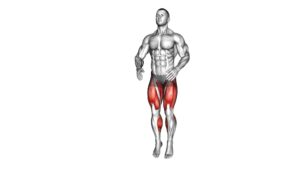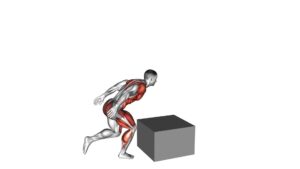Single Leg Vertical Jump – Video Exercise Guide & Tips

Are you looking to improve your vertical jump?
Watch This Exercise Video
In this video exercise guide, we'll show you how to master the single leg vertical jump. This explosive move targets your lower body, helping you build strength and power.
We'll walk you through the proper technique, common mistakes to avoid, and variations to challenge yourself.
Maximize your results with our helpful tips. Get ready to elevate your jump game and reach new heights!
Key Takeaways
- Increased power and stability
- Targets muscles in the legs
- Enhances explosive strength
- Improves balance and strengthens stabilizer muscles
Benefits of Single Leg Vertical Jump
You can experience increased power and stability through the practice of Single Leg Vertical Jump. This exercise isn't only beneficial for improving explosiveness, but it also plays a crucial role in injury prevention.
When you perform Single Leg Vertical Jumps, you're engaging the muscles in your legs, particularly the quadriceps, hamstrings, and calves. These muscles are responsible for generating power and propelling you upwards. By repeatedly practicing this exercise, you can enhance the explosive strength in your lower body, allowing you to jump higher and with more force.
Furthermore, Single Leg Vertical Jumps require a great deal of balance and stability. When you jump off one leg, you're forced to activate the stabilizer muscles in your ankles, knees, and hips. This not only helps to improve your balance but also strengthens these muscles, reducing the risk of injuries such as ankle sprains or knee instability.
Incorporating Single Leg Vertical Jumps into your training routine can be highly beneficial, whether you're an athlete looking to enhance your performance or an individual seeking to prevent injuries. By focusing on improving explosiveness and building stability, this exercise can help you reach new heights in your athletic endeavors while keeping you safe from potential injuries.
Proper Technique for Single Leg Vertical Jump
Mastering the proper technique for Single Leg Vertical Jump requires focus and precision. This exercise is commonly used in basketball training to improve explosiveness and power in a player's jump.
To perform the single leg vertical jump, start by standing on one leg with a slight bend in the knee. Keep your core engaged and your arms extended in front of you for balance. From this position, quickly explode off the ground using your leg muscles, driving your knee up towards your chest. Extend your ankle, knee, and hip as you jump, reaching as high as possible. Land softly on the same leg, absorbing the impact by bending your knee and maintaining stability.
To increase explosiveness in this exercise, focus on generating power from the hip and ankle joints. Incorporate plyometric exercises and strength training for the lower body, such as squats and lunges, to build the necessary strength and power.
By practicing proper technique and incorporating explosive training methods, you can improve your single leg vertical jump and enhance your basketball performance.
Transitioning into the next section about common mistakes to avoid, it's important to be mindful of these errors in order to maximize your results.
Common Mistakes to Avoid in Single Leg Vertical Jump
One common mistake to avoid in the Single Leg Vertical Jump is failing to maintain proper alignment of the supporting leg. When performing this exercise, it's crucial to ensure that your supporting leg remains in line with your hip, knee, and ankle. Deviating from this alignment can put unnecessary stress on your joints, increasing the risk of injury.
To help you avoid this mistake and maximize the effectiveness of your Single Leg Vertical Jump, here are three important tips:
- Keep your knee in line with your hip and ankle: To maintain proper alignment, make sure your knee is directly above your ankle throughout the movement. Avoid letting your knee cave inwards or shift outwards, as this can lead to instability and potential injury.
- Engage your core and stabilize your hips: Your core plays a vital role in maintaining stability during the Single Leg Vertical Jump. By engaging your core muscles and stabilizing your hips, you can ensure proper alignment and reduce the risk of injury.
- Land softly and absorb the impact: When landing from the jump, it's important to land softly and absorb the impact with your muscles, rather than relying solely on your joints. This can help prevent excessive stress on your joints and reduce the risk of injury.
Variations and Progressions for Single Leg Vertical Jump
To continue exploring the Single Leg Vertical Jump, let's delve into variations and progressions that can enhance your training.
Adding variations to your single leg jump exercises can help target different muscle groups and improve overall power and explosiveness. One variation you can try is the Single Leg Box Jump. Find a sturdy box or platform and jump onto it with one leg, focusing on exploding off the ground and landing softly.
Another variation is the Single Leg Depth Jump, where you start on a higher surface, step off with one leg, and immediately jump as high as possible upon landing. This exercise helps to develop reactive strength and power in your legs.
Progressions are also important in single leg power training. Once you have mastered the basic single leg jump exercises, you can progress to more advanced variations.
One progression is the Single Leg Plyometric Squat Jump, where you perform a squat jump on one leg, emphasizing the explosive upward movement.
Another progression is the Single Leg Squat Jump with a Medicine Ball Toss, where you hold a medicine ball and explosively jump off one leg while simultaneously tossing the ball forward.
By incorporating these variations and progressions into your single leg power training, you can continue to challenge your muscles and improve your vertical jump.
Now, let's move on to the next section to learn some tips for maximizing your single leg vertical jump results.
Tips for Maximizing Your Single Leg Vertical Jump Results
To maximize your single leg vertical jump results, you should focus on incorporating key training techniques that will help you reach your goals. Here are three tips to help you achieve maximum results:
- Progressive Overload: Gradually increase the intensity of your training to challenge your muscles and improve your jumping ability. Start with bodyweight exercises and then gradually add resistance through weights or resistance bands. This will help build strength and power in your legs, allowing you to jump higher.
- Plyometric Training: Incorporate plyometric exercises into your training routine. These explosive movements, such as box jumps or depth jumps, improve your ability to generate power and force through your legs. Plyometrics can significantly enhance your single leg vertical jump by improving your reactive strength and fast-twitch muscle fibers.
- Proper Recovery: Allow your body enough time to recover between training sessions. Rest and recovery are essential for muscle growth and injury prevention. Make sure to get enough sleep, eat a balanced diet, and incorporate stretching and foam rolling into your routine to prevent muscle tightness and reduce the risk of injury.
Frequently Asked Questions
How Does the Single Leg Vertical Jump Benefit Other Athletic Activities?
When it comes to sports, the single leg vertical jump offers a multitude of benefits. By focusing on one leg at a time, you improve balance, stability, and explosiveness.
This translates to better performance in activities like basketball, volleyball, and soccer, where jumping is crucial.
To enhance your single leg vertical jump, practice plyometric exercises and strength training for your legs.
With dedication and proper technique, you'll see significant improvements in your overall athletic abilities.
Can the Single Leg Vertical Jump Be Performed by Individuals of All Fitness Levels?
Yes, the single leg vertical jump can be performed by individuals of all fitness levels. It's a versatile exercise that can be modified to suit your abilities.
The benefits of single leg exercises, like the vertical jump, include improved balance, stability, and lower body strength.
There are progressions you can follow to gradually increase the difficulty of the exercise as you get stronger.
Are There Any Specific Warm-Up Exercises Recommended Before Attempting the Single Leg Vertical Jump?
Before attempting the single leg vertical jump, it's important to warm up your body properly.
Dynamic stretches like leg swings and hip circles can help loosen up your muscles and improve your range of motion.
Additionally, incorporating plyometric exercises such as jump squats or box jumps can activate your muscles and prepare them for explosive movements.
These warm-up exercises won't only reduce the risk of injury but also enhance your performance during the single leg vertical jump.
How Often Should the Single Leg Vertical Jump Be Incorporated Into a Workout Routine?
To determine how often you should incorporate the single leg vertical jump into your workout routine, consider your fitness goals and current level of strength and conditioning.
This exercise can be challenging, so start by incorporating it 1-2 times per week and gradually increase the frequency as you become more comfortable and proficient.
Additionally, you can vary the intensity and difficulty of the exercise by adjusting the height of the jump or adding weights to increase resistance.
Are There Any Modifications or Adaptations for Individuals With Joint or Mobility Limitations?
If you have joint limitations, there are modifications you can make to the single leg vertical jump exercise. Instead of jumping, you can try a modified version where you perform a single leg squat or step-up. This will reduce the impact on your joints while still working your leg muscles.
For individuals with mobility limitations, adaptations can be made by using a lower box or step to jump onto, or by performing the exercise with a smaller range of motion.
Conclusion
In conclusion, the single leg vertical jump is an effective exercise for improving lower body strength and power. By following proper technique and avoiding common mistakes, you can maximize your results and enhance your athletic performance.
Additionally, incorporating variations and progressions into your training can provide added challenge and help you continue to progress.
So, if you're looking to boost your vertical jump, give the single leg vertical jump a try and see the difference it can make.

Author
Years ago, the spark of my life’s passion ignited in my mind the moment I stepped into the local gym for the first time. The inaugural bead of perspiration, the initial endeavor, the very first surge of endorphins, and a sense of pride that washed over me post-workout marked the beginning of my deep-seated interest in strength sports, fitness, and sports nutrition. This very curiosity blossomed rapidly into a profound fascination, propelling me to earn a Master’s degree in Physical Education from the Academy of Physical Education in Krakow, followed by a Sports Manager diploma from the Jagiellonian University. My journey of growth led me to gain more specialized qualifications, such as being a certified personal trainer with a focus on sports dietetics, a lifeguard, and an instructor for wellness and corrective gymnastics. Theoretical knowledge paired seamlessly with practical experience, reinforcing my belief that the transformation of individuals under my guidance was also a reflection of my personal growth. This belief holds true even today. Each day, I strive to push the boundaries and explore new realms. These realms gently elevate me to greater heights. The unique combination of passion for my field and the continuous quest for growth fuels my drive to break new ground.



